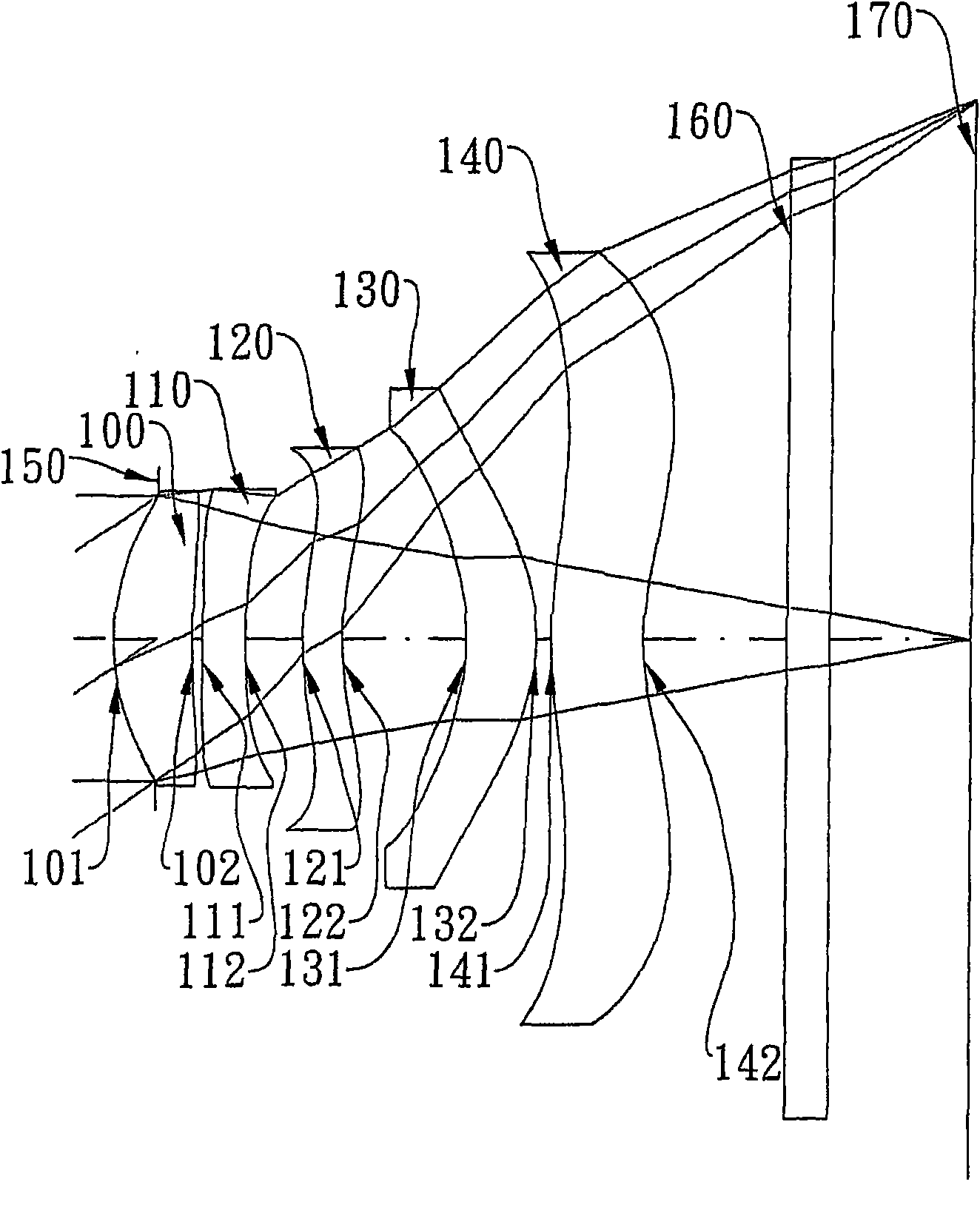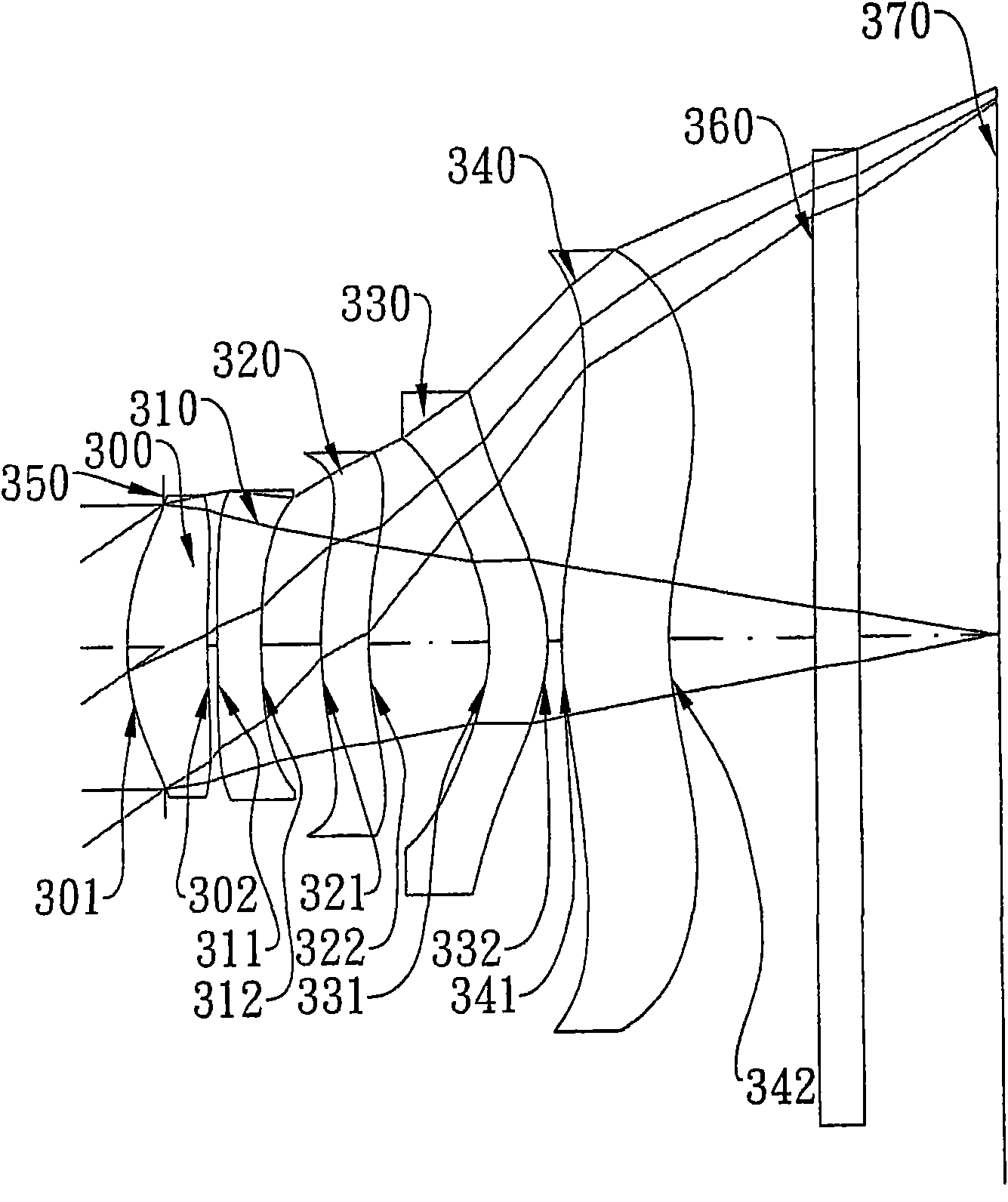Photographic lens system
A technology of camera lens and lens, which is applied in the parts of TV system, image communication, TV, etc., can solve the problem of not being able to meet the needs of camera lens modules, and achieve the effects of shortening the total optical length, improving imaging quality, and increasing photosensitive sensitivity
- Summary
- Abstract
- Description
- Claims
- Application Information
AI Technical Summary
Problems solved by technology
Method used
Image
Examples
no. 1 example
[0085] Please refer to the first embodiment of the present invention figure 1 , for the aberration curve of the first embodiment, please refer to figure 2 . The imaging lens system of the first embodiment is mainly composed of five lenses, which include in sequence from the object side to the image side:
[0086] A first lens 100 with positive refractive power, its object-side surface 101 is convex and image-side surface 102 is concave, and its material is plastic. The object-side surface 101 and image-side surface 102 of the first lens 100 are both non- sphere;
[0087] A second lens 110 with negative refractive power, its object-side surface 111 is convex and image-side surface 112 is concave, and its material is plastic. The object-side surface 111 and image-side surface 112 of the second lens 110 are both non- sphere;
[0088] A third lens 120 with negative refractive power, its object-side surface 121 is convex and image-side surface 122 is concave, and its material ...
no. 2 example
[0118] Please refer to the second embodiment of the present invention image 3 , for the aberration curve of the second embodiment, please refer to Figure 4 . The imaging lens system of the second embodiment is mainly composed of five lenses, which sequentially include from the object side to the image side:
[0119] A first lens 300 with positive refractive power, its object-side surface 301 is convex and image-side surface 302 is concave, and its material is plastic. The object-side surface 301 and image-side surface 302 of the first lens 300 are non- sphere;
[0120] A second lens 310 with negative refractive power, its object-side surface 311 is convex and image-side surface 312 is concave, and its material is plastic. The object-side surface 311 and image-side surface 312 of the second lens 310 are both non- sphere;
[0121] A third lens 320 with positive refractive power, its object-side surface 321 is convex and image-side surface 322 is concave, and its material i...
no. 3 example
[0145] Please refer to the third embodiment of the present invention Figure 5 , for the aberration curve of the third embodiment, please refer to Figure 6 . The imaging lens system of the third embodiment is mainly composed of five lenses, which sequentially include from the object side to the image side:
[0146] A first lens 500 with positive refractive power, its object side surface 501 is convex and image side surface 502 is concave, its material is plastic, the object side surface 501 and image side surface 502 of the first lens 500 are both non- sphere;
[0147] A second lens 510 with negative refractive power, its object-side surface 511 is convex and image-side surface 512 is concave, and its material is plastic. The object-side surface 511 and image-side surface 512 of the second lens 510 are non- sphere;
[0148] A third lens 520 with positive refractive power, its object-side surface 521 is convex and image-side surface 522 is concave, and its material is plas...
PUM
 Login to View More
Login to View More Abstract
Description
Claims
Application Information
 Login to View More
Login to View More - R&D
- Intellectual Property
- Life Sciences
- Materials
- Tech Scout
- Unparalleled Data Quality
- Higher Quality Content
- 60% Fewer Hallucinations
Browse by: Latest US Patents, China's latest patents, Technical Efficacy Thesaurus, Application Domain, Technology Topic, Popular Technical Reports.
© 2025 PatSnap. All rights reserved.Legal|Privacy policy|Modern Slavery Act Transparency Statement|Sitemap|About US| Contact US: help@patsnap.com



